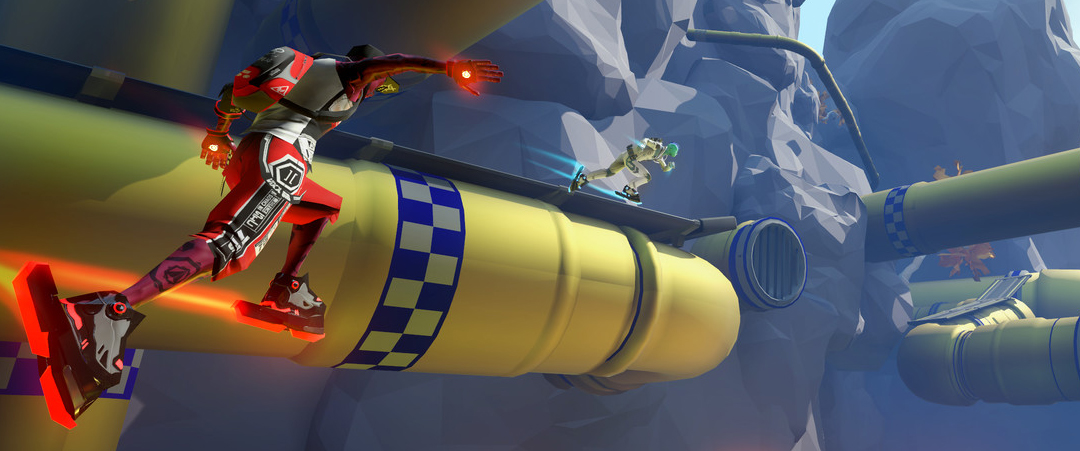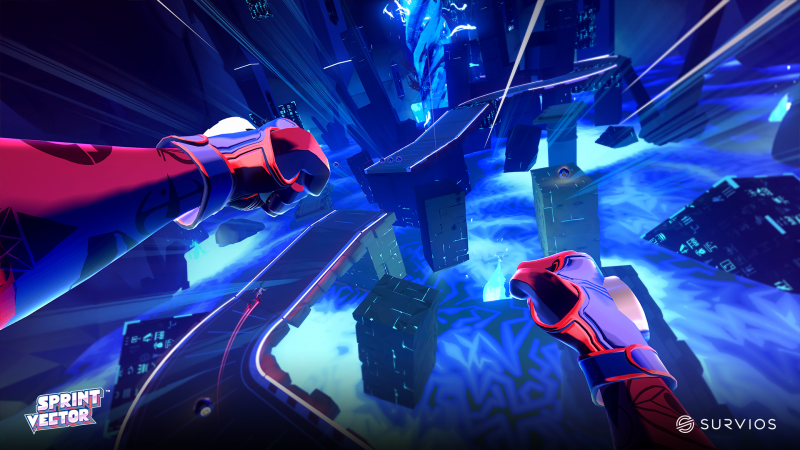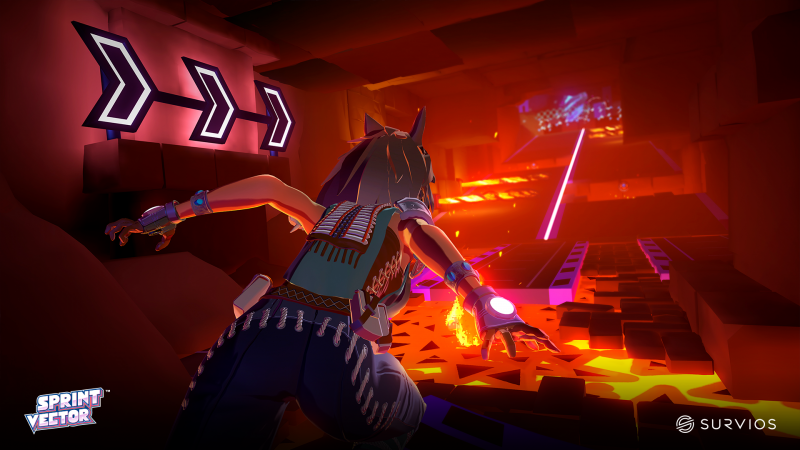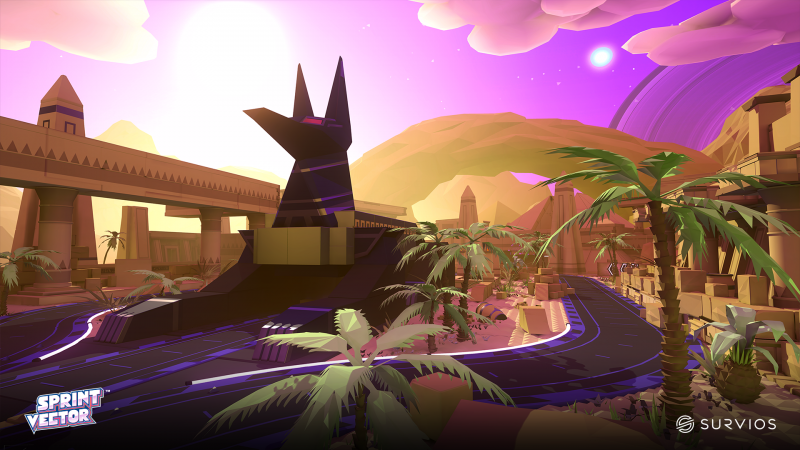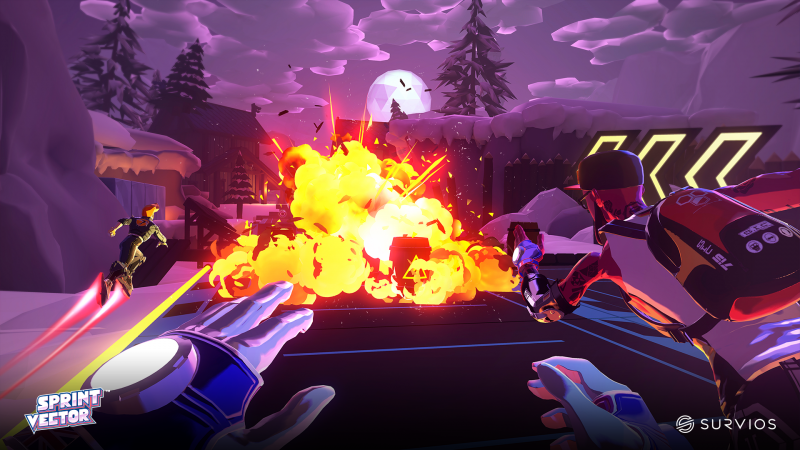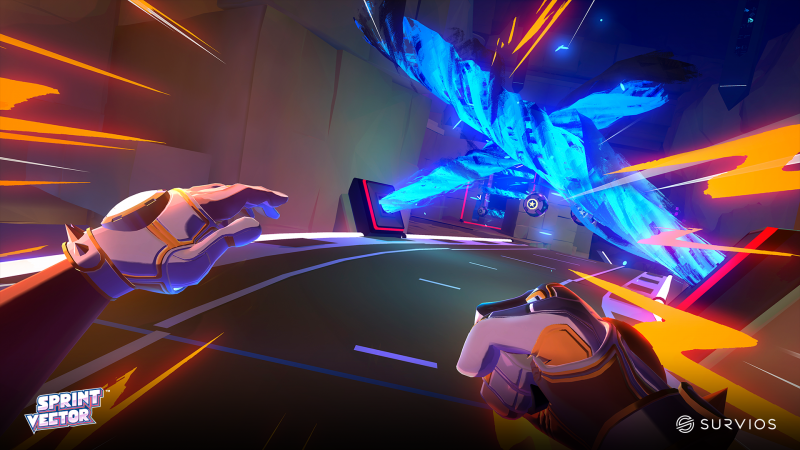Sprint Vector Review (HTC Vive/Oculus Rift)
For the purposes of transparency, this review was created using a code provided by the company or their respective PR company. The use of a review code does not affect my judgement of the game.
After spending some time in the beta of Sprint Vector, I could not wait to get my hands on the full game. The full release of the game was released on 8th February on HTC Vive and Oculus Rift, and I have spent more time with it. So, did the full game keep up with my high expectations from the beta?
The game comes from the team Survios who brought us Raw Data. What I liked is they have moved onto something different from their last title, and tried something not only new to them, but also unique to the VR platform. I described the game in my hands-on as TRON without bikes, more running/skating – and I still stick to that.
The game offers a slight introduction/story, but it is not filled out in any way, and with it being a racing game it’s not really required. As you load in the game you are introduced to Mr. Entertainment and over excitable/quirky robot presenter, and he explains he has the best racers for around the galaxy for this years Sprint Vector Championship Intergalacticer. That is it but as previously mentioned it is all the game needs.
Sprint Vector is all about the gameplay, and the team at Survios have brought exhilarating and unique gameplay, that has not been seen in a VR game before. It’s so much more than a racing game because the courses are also obstacle courses in their own rights. Yes, the running motion is the main mechanic in the game, which involves swinging your arms in tandem and releasing the trigger at the correct time to gain more speed. But, a lot more skills also need learning to become the Championship Intergalacticer number one.
The mechanics you are going to have to use are sprinting, jumping, flying, drifting, climbing, swinging, slamming and shooting. Getting all these mechanics down and learning when is best to implement them does come with a learning curve – but after about and hour with the game I started to get used to them. The game does offer a tutorial to teach you how to do all of these, and really it is essential you do them all. When starting the tutorials it will seem doing the first part of the tutorial is only needed with the way it is explained – however, ignore this and complete them all.
As well as the movement, the game will also throw power-ups at you – these play-out in a Mario Kart-esc style. You will need to run into the power-up orbs placed around the track, and these will grant you a set item. These range from Nitro boosts to give you that edge over your opponents (also gives you a break from swinging your arms), projectiles to fire at your opponents or mines to place to catch them out. Again, part of the tutorial is a power-up practice arena and I would recommend spending sometime in this area, learning the properties of each power-up.
Putting all of this together really does bring a fast paced, entertaining, heart-pumping and exercise filled experience – which will require a lot a skill to become the best of the best. What really impressed me was even though you will feel you are moving at such a fast pace and the exercise involved you will not feel any motion sickness or uncomfortable while you are playing it. OK, if you are not very fit (like me) you may ache the next day if you play for long sessions and everyone should expect to sweat – if you don’t your not playing it properly.
The game comes with single player and multiplayer modes, and both modes will keep you entertained never mind how you want to play the game. If you prefer single player you can race against AI on different difficulty settings, which will all provide some decent competition. In single player you also get a challenge mode, which consists of nine different challenges and believe me by the end they get difficult – I still haven’t managed some of them at the point of writing this review. Which for a single player element it gives you plenty to do, if you not comfortable or ready to take on others.
Multiplayer only offers races against eight other players, and this is really where the competition steps-up and you start to feel that cardio workout. I found that you seemed more tired from the multiplayer races, this could be down to being more determined to win and prove your skills against other people. For me the multiplayer felt more rewarding when you win as well, and certainly when you pull of some real skills. There’s not a better feeling of pulling of a combo of the movement mechanics and landing a power-up on another player, as you overtake them wishing they could see the smirk on your actual face.
When it comes the characters and races, you will get a selection of eight different characters, and get to race around twelve different tracks. Which I don’t think is a bad amount of content, because learning all the tracks and every tracks possible routes is going to take a long time – never mind mastering them.
When it comes down to the games presentation, it really makes me think of Jet Set Radio. From the games cell-shaded visuals to the soundtrack. The games overall presentation style stands up tall with the gameplay, because even when you moving through these courses at the break-neck speeds, you will still take notice of how nice the tracks look. When it comes to the audio there is a vast array of musical tracks that will play, making sure you don’t get sick of the background music quickly – well I still haven’t so far. They then add the humorous commentary and announcers over the top, making everything about the presentation top-notch.
The controls are all very intuitive, and there is a lot of combinations to learn – but as previously mentioned after time with the game they will become second nature. The game can be played standing, seated or using room-scale meaning everyone can get involved in Sprint Vector. However, I have yet tried to play the game seated. One issue I had with the Oculus Rift was the tracking sometimes got lost – but that could be down to my two sensor set-up and I seemed to move around a lot without really noticing. I also found one issue with the controller set-up on the HTC Vive, I mentioned this in my hands-on and that is the placement of the break. This is applied to the grips on the side of the controller, which are easy to squeeze in when you get into the racing and grip the controller harder by accident. I think an option to customise the controls wouldn’t go a miss in the game.
Sprint Vector really has unlimited longevity if you take to the game. I really see myself returning the game often and trying to beat the challenges I have yet to do, and trying to master the tracks and gain some number one finishes in the multiplayer races. For the price point of £22.99 it really is a no-brainer when it comes to buying the game or not – be it for the unique gameplay or the fun and exercise you will get while playing it.
Conclusion
Sprint Vector brings a great competitive e-Sport to the VR platform – something I have been missing since losing the urge to play Sparc. The team at Survios have really made something 100% unique with Sprint Vector in every aspect; from the gameplay to the control system. Adding to it a visual style and music which matches the gameplay and is just as strong. I would highly recommend putting on that VR headset, strapping on those virtual skates and jumping into this exhilarating game.
Also available on Playstation VR
Developer: Survios

